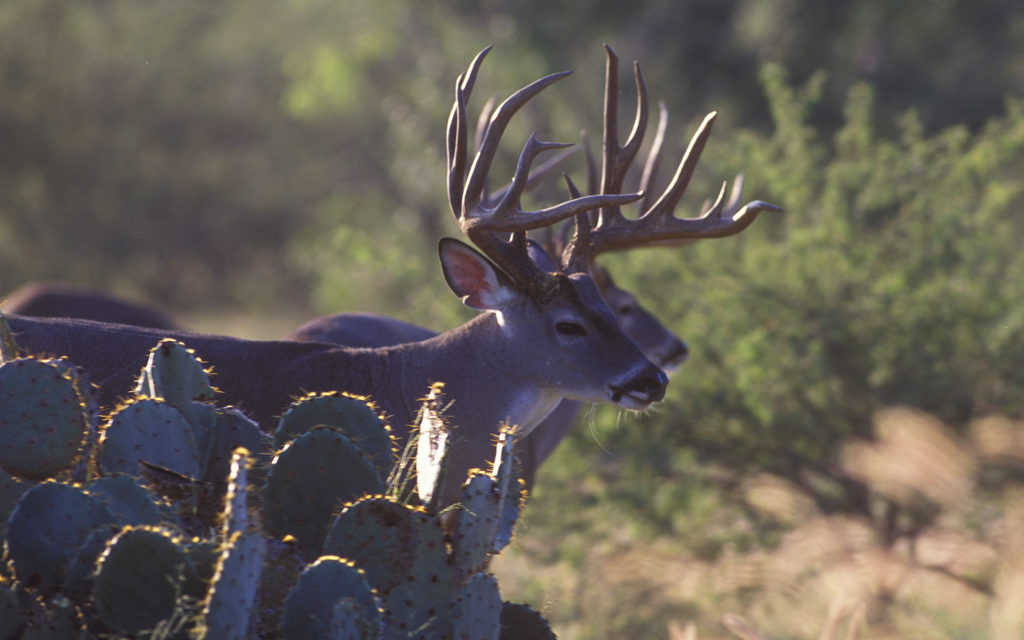by John Jefferson
Coming out of a summer that recorded 32 days of over 100-degree temperatures with some highs hovering around 110 might sound gloomy to deer hunters. But Texas whitetail deer are one of God’s most adaptable critters — second only to Wile E. Coyote. Coyotes make a living off an endless menu of meal possibilities. Deer are vegetarians with a diet more dependent on the weather – particularly rainfall. But, they make out by seeking out food where they can find it during droughts. They prefer forbs – weedy stuff – but can successfully shift to woody plants as conditions dictate.
Add agricultural crops, neighborhood gardens and flower beds – even year-around deer feeders — and the fittest survive. Then, there’s the old adage “If you don’t like Texas weather, just stick around!”
Man, does that apply this year! Most of Texas had a decent spring forb production and the brush greened-up, providing a good start to antler development. Then, summer conditions began diminishing. That’s where the woody brush species of plants came into play until the weather changed. And, Man, did it.
 South of Kingsville, some areas gauged 21 inches of rain in July! Alan Cain, TPWD’s white-tailed deer program leader, said it looked “… like a jungle with all the green vegetation.” He added that a good mesquite bean crop was developing and would nourish deer in areas with mesquites. In Central Texas, there were 17 consecutive September rainy days, making it one of the wettest ever. And more rain is forecast. If you hunted doves, you probably swatted a few mosquitoes.
South of Kingsville, some areas gauged 21 inches of rain in July! Alan Cain, TPWD’s white-tailed deer program leader, said it looked “… like a jungle with all the green vegetation.” He added that a good mesquite bean crop was developing and would nourish deer in areas with mesquites. In Central Texas, there were 17 consecutive September rainy days, making it one of the wettest ever. And more rain is forecast. If you hunted doves, you probably swatted a few mosquitoes.
The rain means deer will be in good shape. The bad news for hunters around deer feeders is that deer will prefer the native vegetation to corn and protein early in the season. Trail camera pictures I’ve seen show fine antler development, but most are night-time shots. That will change with cooler weather, shorter amounts of daylight, and the upcoming rut. But the deer are here, and healthy. Texas has nearly 4.6 million deer, dispersed over most of the state, according to Cain’s TPWD surveys.
The Edwards Plateau, AKA the Hill Country, has the most, around 2.6 million, according to Cain. Areas around Mason, Llano, and neighboring counties have the highest density. A good fawn crop in 2015 will mean more bucks 3.5 years of age, and the 2013 crop will add 5.5-year-old bucks this season.
The Cross Timbers Region north of the Hill Country, has the second highest population. Hunters there may see a few more bucks in the 6.5-year age class due to good fawn recruitment in 2012. In South Texas, there’ll be many larger bucks, although perhaps slightly fewer 6.5-year-olds. Highest scoring bucks will be found in South Texas and the Western Rolling Plains.
Cain projects average antler quality all across Texas – and “average for Texas” is highly coveted elsewhere. We are blessed.
“Each year, many quality bucks are taken in every ecoregion,” Cain points out. “That buck of a lifetime could be in your neck of the woods!”
JJ





